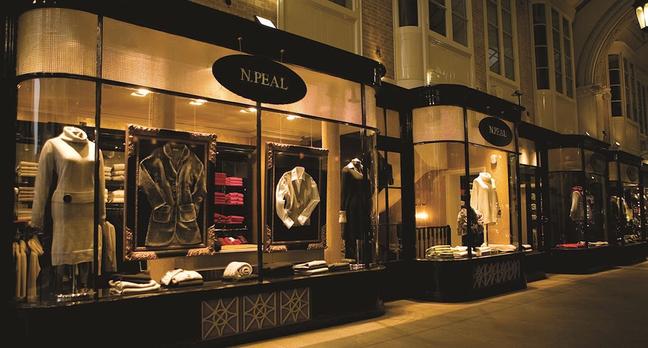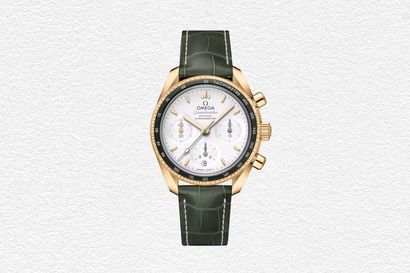Behind the brand: the luxury cashmere label with a difference
We take a closer look at N.Peal, the cashmere brand that's standing out
It was exactly eighty years ago that Nat Peal discovered a vacancy in the Burlington Arcade in the heart of Mayfair, where global luxury cashmere brand N. Peal still stands today. Whilst stationed in Scotland during the war, Peal was inspired by the quality of Shetland wool, and business boomed as he was able to provide quality product during a period of rationing. Peace was declared and business boomed further.
Adam Holdsworth, current owner and MD, comes from a family textile background. An expert in cashmere manufacture, Holdsworth understands every junction of making the ultimate sweater: from the goats on those cold Mongolian steppes, to the design of a finished fashion garment, he has stayed true to his word and given N. Peal a renewed direction as a brand.
We sit down with Adam to discuss the past eighty years of the N. Peal brand, including his personal inspiration, his familiarity with its past, and what is in store for the future. Holdsworth provides insight on the N. Peal customer portfolio, which has always been a Hollywood mafia including Audrey Hepburn, Marilyn Monroe, Cary Grant, through to Dustin Hoffman and Michael Caine, until most recently, Daniel Craig playing Bond in Spectre, which featured three jumpers from the Autumn/Winter 2015 range.
Founded in 1936, N. Peal quickly became synonymous with exceptional cashmere goods — and has been ever since. After cornering the premium wool market in late 1930’s Britain, founder Nat Peal set his sights on America. He began by making yearly trips to New York and Boston, where he proved that he knew how to put on a good show. He would always set himself up in the most luxurious suite of the finest hotel — a canny move that provided him with the ideal setting in which to impress wealthy clients and entertain members of the press. With his transatlantic reputation on the rise, Nat found his clothes ascending to the utmost heights of fashion royalty; N. Peal garments were soon adorning the backs of some of America’s greatest stars. N. Peal had entered in to that cradle of post-war glamour, Hollywood. “The brand first saw real success in the fifties, which were defined by this extensive travel to America. Development of the customer portfolio on the East Coast and particularly the West Coast, including all of the Hollywood stars was a defining era for the company in terms of cementing the reputation as the go-to supplier of cashmere knitwear, both in the UK and now America,” Adam explains. “This lasted right the way through the fifties, sixties and seventies.”

N. Peal at Burlington arcade
What changed in the eighties and nineties was the growth of the ‘mega-brand’. As defined by AdWeek, a megabrand relates to taking a power brand and extending its equity across related product categories to drive growth and efficiencies. The public became consumed with one name that effectively dominated their lives across fashion, accessories, beauty, fragrance, even electronics and sports equipment. “That was to the detriment of the smaller, local, more specialised boutique businesses like N. Peal that were exceptional, but in just one category,” Adam explains. “They found it a lot tougher during this time as they couldn’t compete with the market takeover. Despite this shift in trend, N. Peal was a brand that customers were genuinely loyal to and passionate about. At the time I bought the brand it was in danger of being lost completely. I felt very strongly that this was a company with such heritage surrounding it that it needed saving, and that’s why I bought it. This inspired approach actually stemmed from a conversation I had with Neville Carter, who will celebrate a 40 year career at N. Peal this September. I didn’t know a huge amount about the luxury goods industry, but you learn and slowly we have built up the brand and stayed very true to the heritage, the high quality that customers expect and we have constantly improved the design of the product and evolved the branding itself as it is a brand that still has a huge amount of substance behind it. It has been a very interesting and exciting journey.”
“What has changed again since is that the consumer has stopped looking purely at brand or brand name, they are wanting more from their experience again, and they are wanting a deeper substance. It is no longer just about the name on the garment, and this is why our recent history is defined by this shift in customer interest. In a way, people are simply reverting back to how they looked at luxury before the mega-brand boom. Going back a few decades, luxury was all about the time it took, the materials and the craftsmanship of the work which subsequently became incredibly expensive. More recently, luxury was defined as very expensive without any real reason why, and usually was associated with a brand. What actually sat behind those products was questionable. I think that is what has changed again. Customers don’t just worry about a flashy name.”
It is no longer just about the name on the garment, and this is why our recent history is defined by this shift in customer interest.
By combining the traditional methods used to harvest its raw product with modern technology, such as state-of-the-art computerised knitting machines, N. Peal remains at the forefront of the cashmere market. Their approach allows them to produce goods that are as luxurious as ever, but in patterns and styles that were once impossible. For the Spring/Summer ’16 collection, N. Peal has extended its Superfine offering, which contains pieces that are light enough for summer wear. The design team took inspiration from the luxurious lifestyle of an English couple holidaying in the Hamptons, focusing on creating transitional pieces that would take one from the city to the beach, then into the evening. As Adam puts it, “You think of cashmere as a winter fibre, and yet it is equally appropriate for summer, whether going for lunch, out and about on the boats or relaxing with a drink in the evening to a setting sun. And where better to encapsulate that lifestyle than the Hamptons – relaxed summer luxury at its best.”
It is Mongolia’s climate that is responsible for the exceptional quality of its cashmere, which comes from the soft down undercoat that keeps the Capra Hircus goat warm during the winter. In certain regions of Mongolia, the goats have to endure temperatures as low as -20 degrees centigrade, which means they develop an extra fine layer of this fur in order to survive. N. Peal has a particularly exacting selection process, using only the fibres that conform to their own rigorous standards for micron, length and colour. Sadly, this sort of commitment to quality isn’t always industry standard. One large British cashmere retailer is currently embroiled in allegations that it has been using adulterated cashmere in products purporting to be 100% pure. In such cases, pure Mongolian cashmere wool is blended with cheaper wools — such as sheep or yak — during production, before coming to market labelled as a 100% pure cashmere product. This fraudulent trade ultimately undermines the livelihood of Mongolian cashmere traders by lowering the demand for the genuine article and fuelling the drive for reduced high-street prices.

The clothes in action
We ask Adam if this meticulous sourcing process existed before his acquisition of the brand. “Whilst they had excellent quality, N. Peal did not have the transparency of supply right the way back to the herders in Mongolia, and that was something I was able to bring to N. Peal and that gave it a great pride and huge strength. It is really that total control of the process from the raw material, to the spinning, knitting and finishing, that allows us to deliver amazing quality to the customer. In this way we deliver a huge amount of value, which until we did this was rare in the luxury sector. That combined with the design work that goes on with our team in London to create modern and contemporary shapes, presses forward the credentials of the brand as a London cashmere supplier.”
A visit to N. Peal’s flagship store is perhaps the best way to experience the brand’s sense of simultaneity, of heritage reinvented. It sits in Mayfair’s Burlington Arcade, an esteemed runway of luxury boutiques that connects Piccadilly with Burlington Gardens. The shop’s styling is a distinct nod to Art Deco style, a movement that celebrated what was at once luxurious and progressive. Yet it is also distinctly modern, meaning that the store not only captures the spirit of N. Peal’s 1930’s heritage, but is a re-imagining of that classic style, and thus a perfect encapsulation of the N. Peal brand as it is today.
“The Burlington Arcade is where N. Peal opened. It has always been our home and always will be our home. I say that substance, a story, a history behind a brand adds to a brand’s quality, and the Arcade is an important element of that story. In terms of a shopping location, it is one of the prime retail spots in the world. It continues to evolve, and just like N. Peal, it modernises and changes and appeals to a regenerating customer base. The new brands that are in the Arcade reflect how the Mayfair landscape is evolving, but the Arcade also remains a historic shopping destination, just as N. Peal maintains its heritage. We have seen N. Peal and the Arcade move through different manifestations, but they will always maintain a synergy.”
I say that substance, a story, a history behind a brand adds to a brand’s quality, and the Arcade is an important element of that story.

When asked what is next for N. Peal, Adam replies, “As luxury retailers, the web and everything that surrounds it is what we are now and will continue to embrace. The fact is that the retail landscape is changing and will continue to change radically. It’s fantastic that we can keep those prominent locations but the growth will be online and that is really exciting, a great challenge and nice to be involved in growing the company in that sphere.” Sounds like N. peal will be charging into the next eighty years full steam ahead.
Visit N. Peal at 37 Burlington Arcade, or visit their website here.

Become a Gentleman’s Journal Member?
Like the Gentleman’s Journal? Why not join the Clubhouse, a special kind of private club where members receive offers and experiences from hand-picked, premium brands. You will also receive invites to exclusive events, the quarterly print magazine delivered directly to your door and your own membership card.


